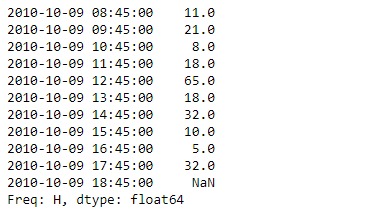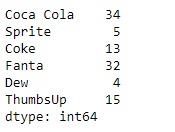Pandas 係列是帶有軸標簽的一維ndarray。標簽不必是唯一的,但必須是可哈希的類型。該對象同時支持基於整數和基於標簽的索引,並提供了許多方法來執行涉及索引的操作。
Pandas Series.autocorr()函數計算lag-N自相關。該方法計算級數及其移位後的自我之間的皮爾遜相關性。
用法: Series.autocorr(lag=1)
參數:
lag:執行自相關之前要應用的滯後次數。
返回:浮點數
範例1:采用Series.autocorr()函數來計算給定係列對象的基礎數據的lag-N自相關。
# importing pandas as pd
import pandas as pd
# Creating the Series
sr = pd.Series([11, 21, 8, 18, 65, 18, 32, 10, 5, 32, None])
# Create the Index
index_ = pd.date_range('2010-10-09 08:45', periods = 11, freq ='H')
# set the index
sr.index = index_
# Print the series
print(sr)輸出:

現在我們將使用Series.autocorr()函數來計算給定係列對象的基礎數據的lag-n自相關。
# return the auto correlation
result = sr.autocorr()
# Print the result
print(result)輸出:

正如我們在輸出中看到的,Series.autocorr()函數已成功將給定係列對象的基礎數據的自動相關性延遲1返回。
範例2:采用Series.autocorr()函數來計算給定係列對象的基礎數據的lag-N自相關。取滯後值等於3。
# importing pandas as pd
import pandas as pd
# Creating the Series
sr = pd.Series([34, 5, 13, 32, 4, 15])
# Create the Index
index_ = ['Coca Cola', 'Sprite', 'Coke', 'Fanta', 'Dew', 'ThumbsUp']
# set the index
sr.index = index_
# Print the series
print(sr)輸出:

現在我們將使用Series.autocorr()函數來計算給定係列對象的基礎數據的lag-n自相關。
# return the auto correlation
# by lag-3
result = sr.autocorr(lag = 3)
# Print the result
print(result)輸出:

正如我們在輸出中看到的,Series.autocorr()函數已成功將給定係列對象的基礎數據的自動相關性延遲1返回。
相關用法
- Python pandas.map()用法及代碼示例
- Python Pandas Series.str.len()用法及代碼示例
- Python Pandas.factorize()用法及代碼示例
- Python Pandas TimedeltaIndex.name用法及代碼示例
- Python Pandas dataframe.ne()用法及代碼示例
- Python Pandas Series.between()用法及代碼示例
- Python Pandas DataFrame.where()用法及代碼示例
- Python Pandas Series.add()用法及代碼示例
- Python Pandas.pivot_table()用法及代碼示例
- Python Pandas Series.mod()用法及代碼示例
- Python Pandas Dataframe.at[ ]用法及代碼示例
- Python Pandas Dataframe.iat[ ]用法及代碼示例
- Python Pandas.pivot()用法及代碼示例
- Python Pandas dataframe.mul()用法及代碼示例
- Python Pandas.melt()用法及代碼示例
注:本文由純淨天空篩選整理自Shubham__Ranjan大神的英文原創作品 Python | Pandas Series.autocorr()。非經特殊聲明,原始代碼版權歸原作者所有,本譯文未經允許或授權,請勿轉載或複製。
